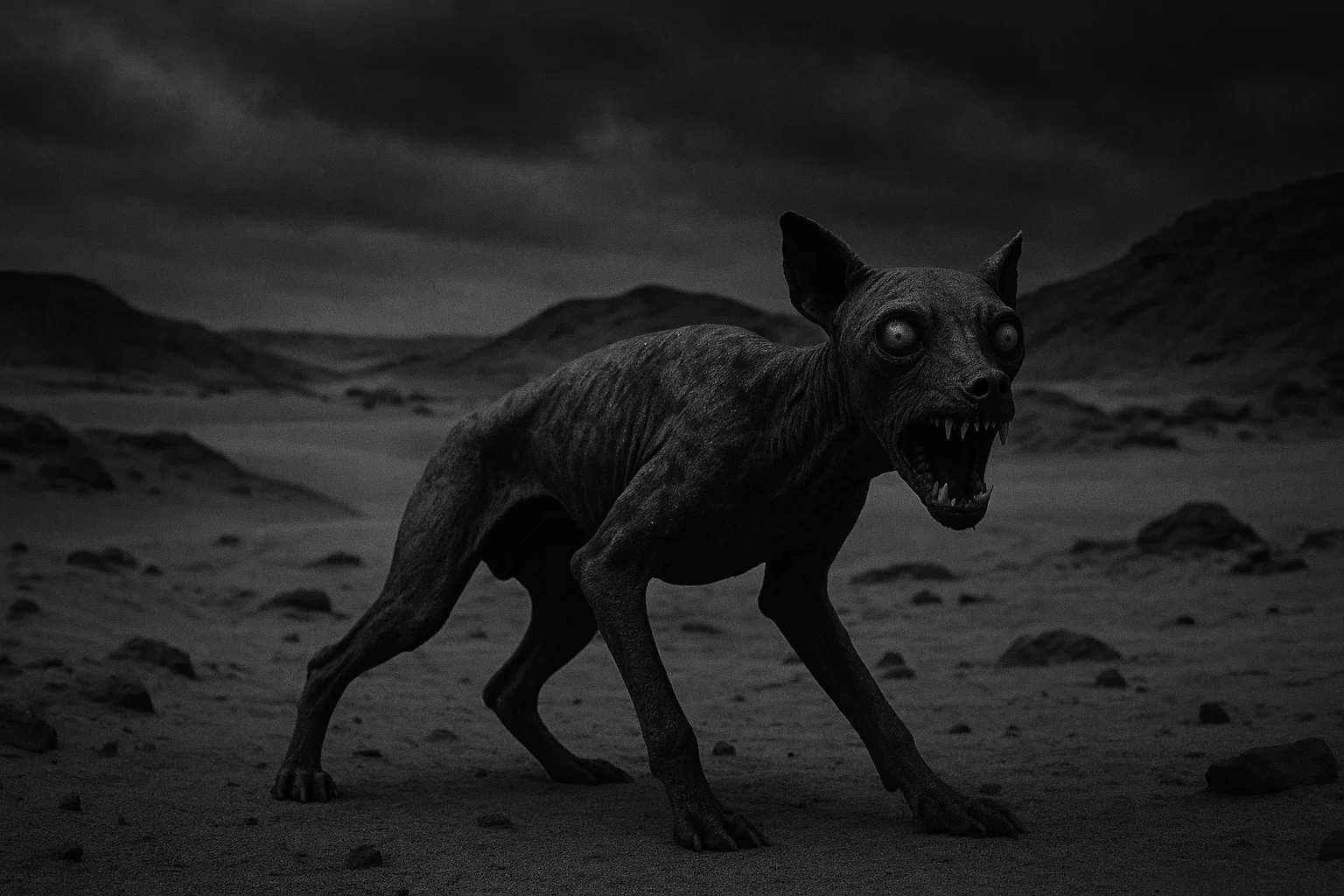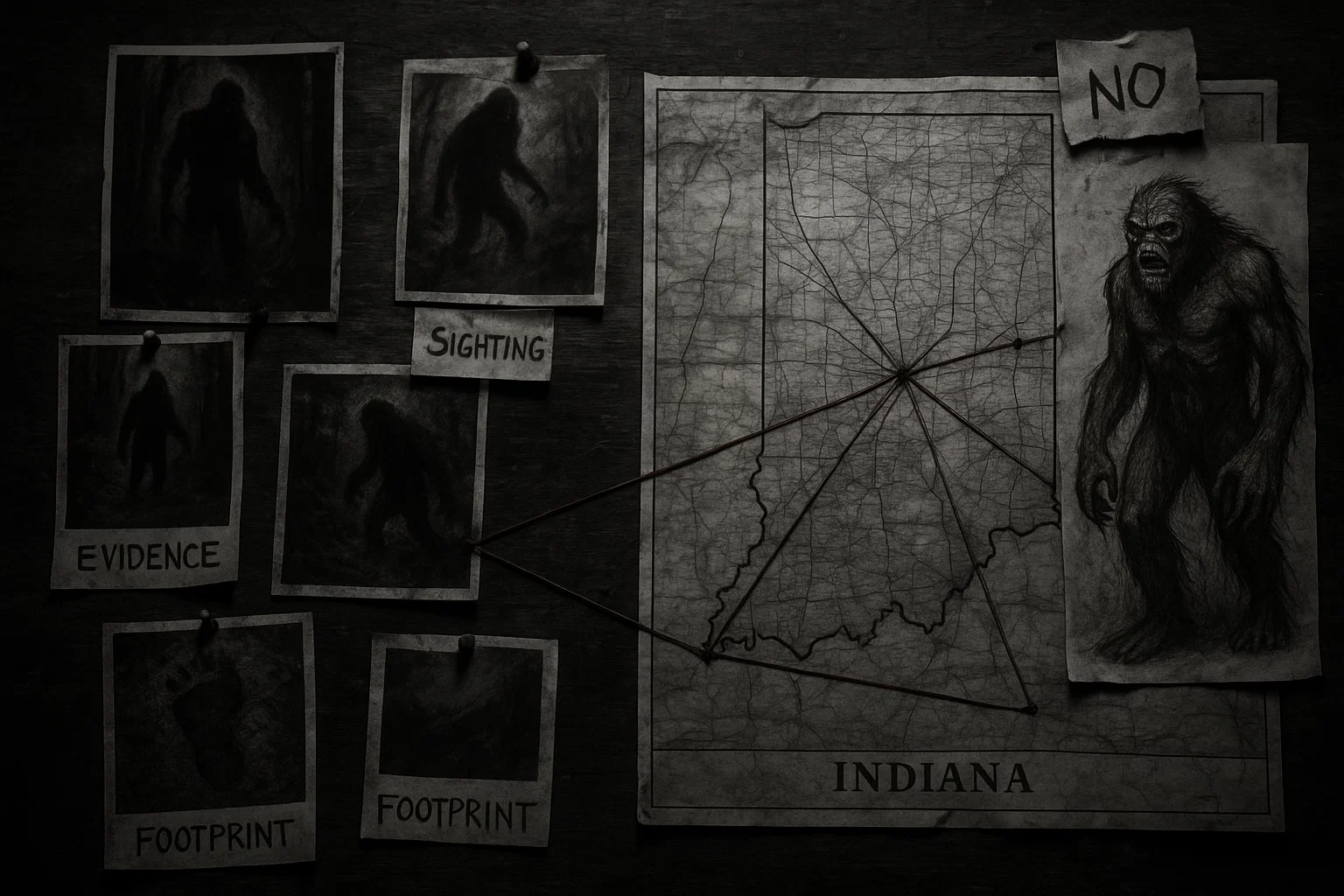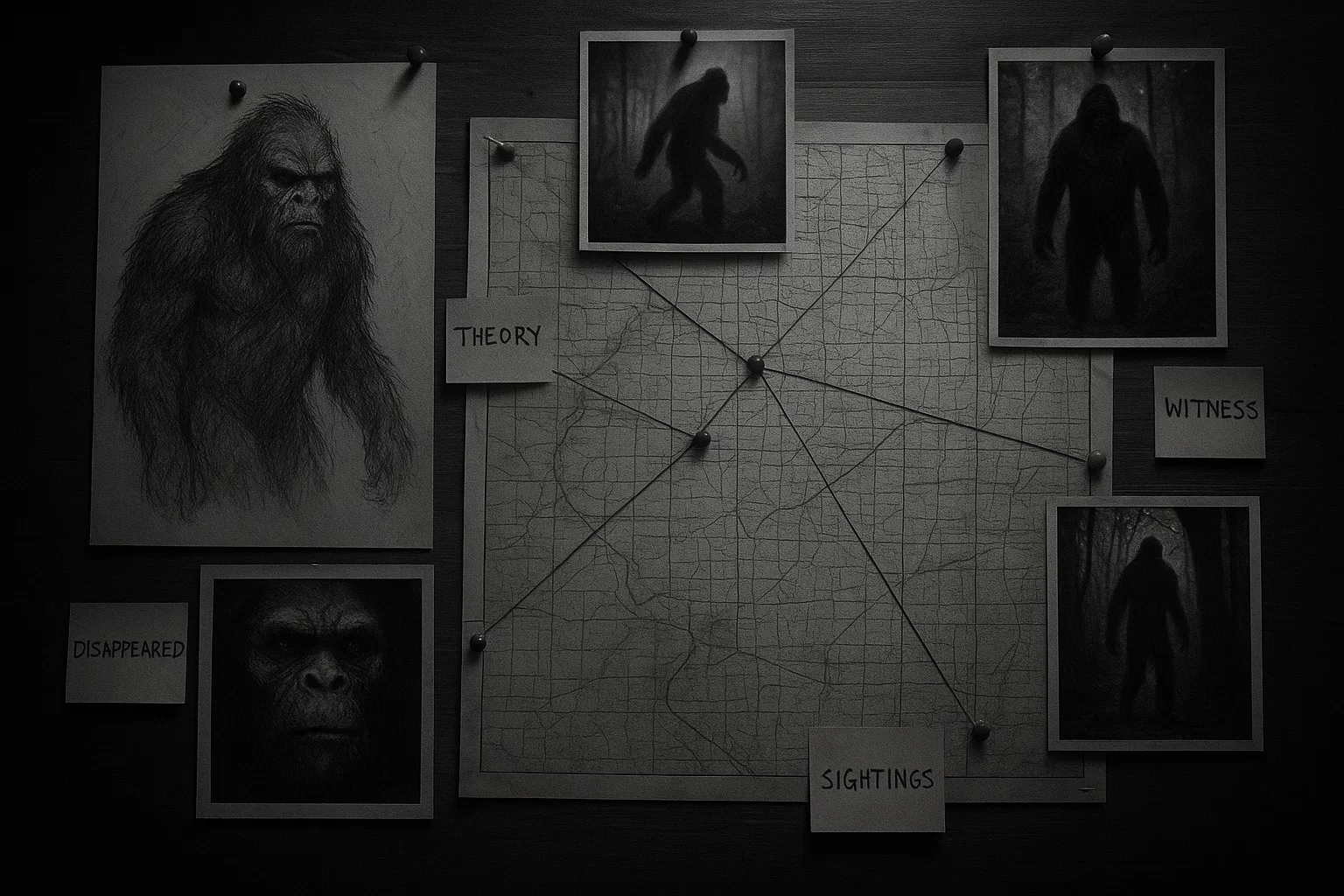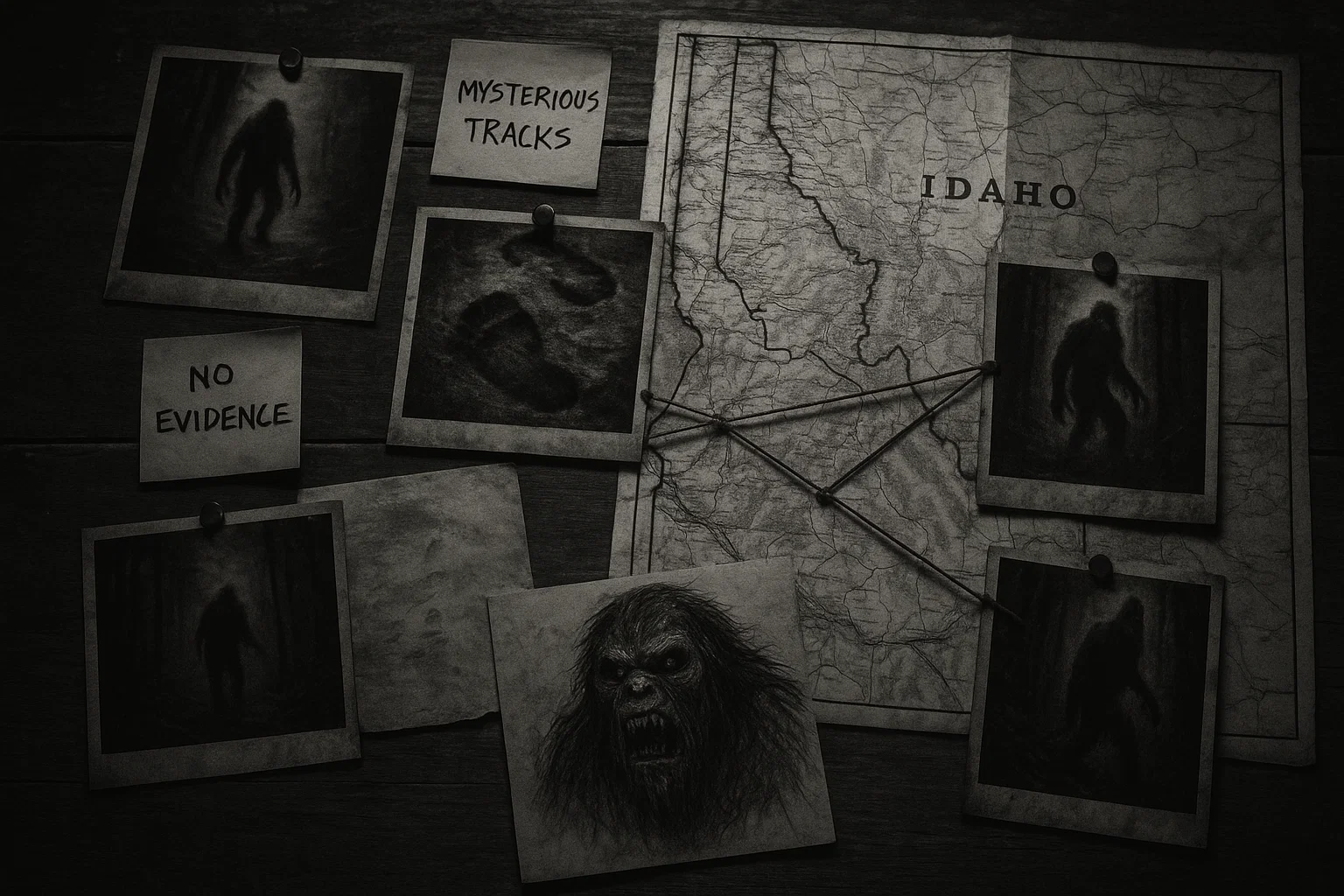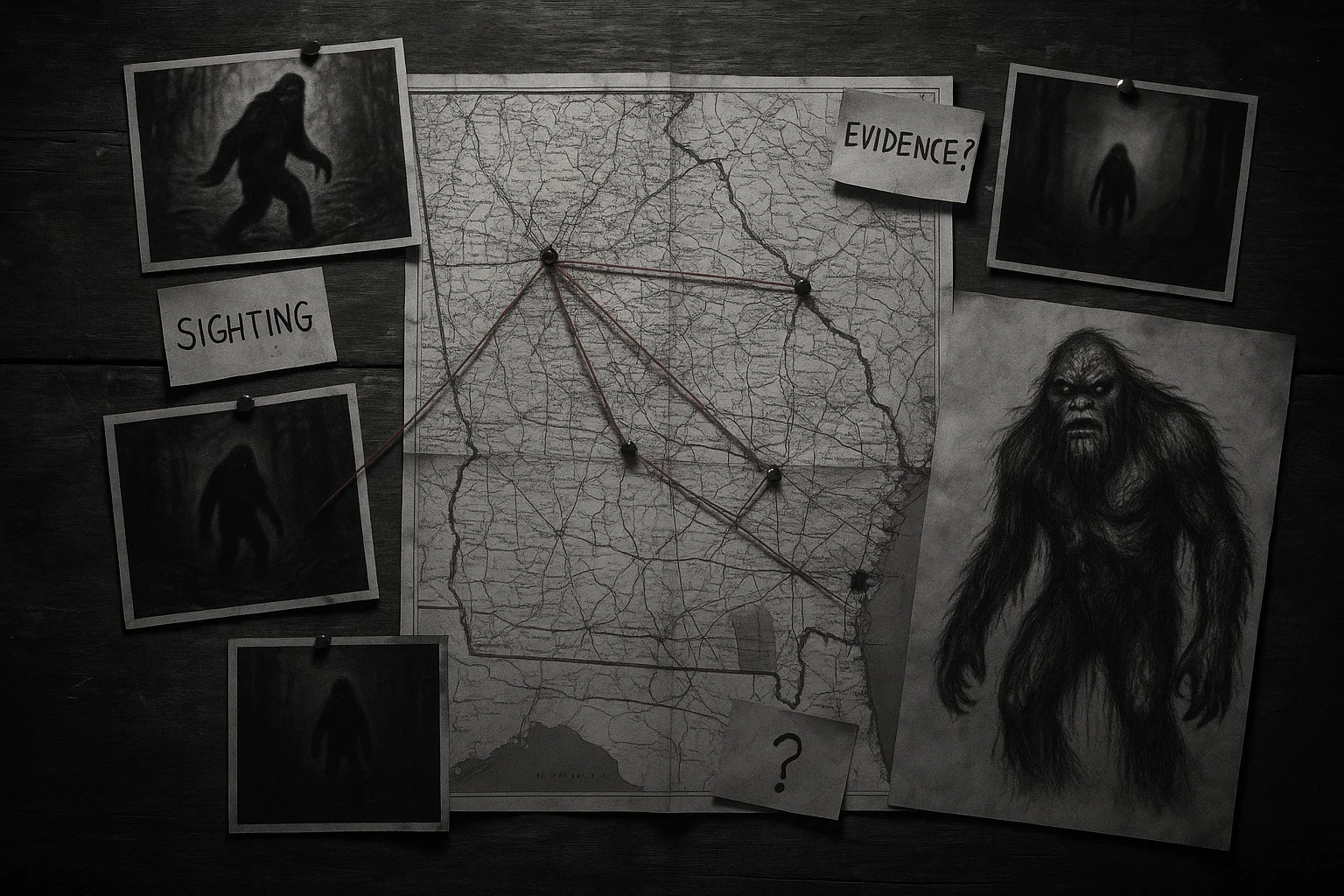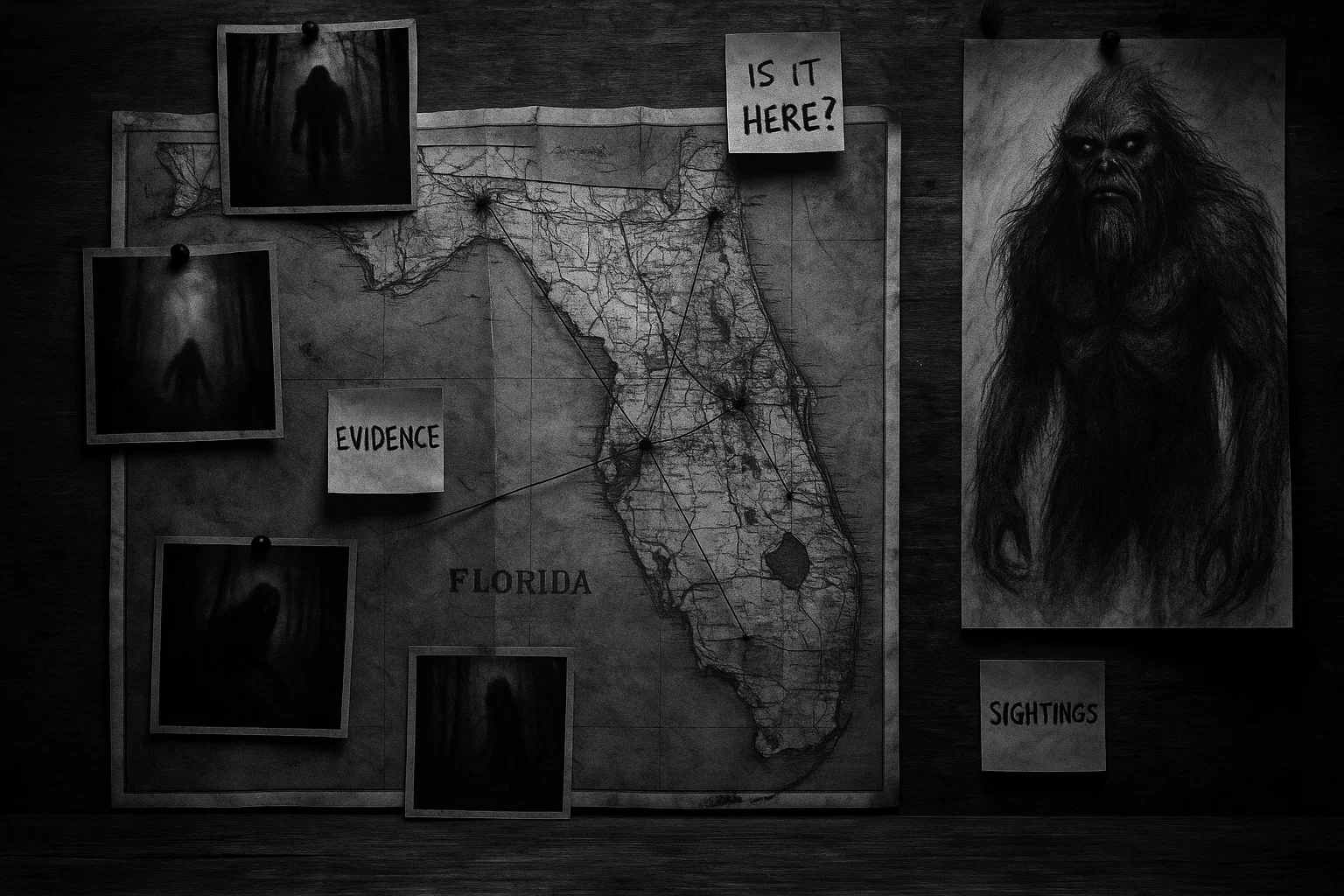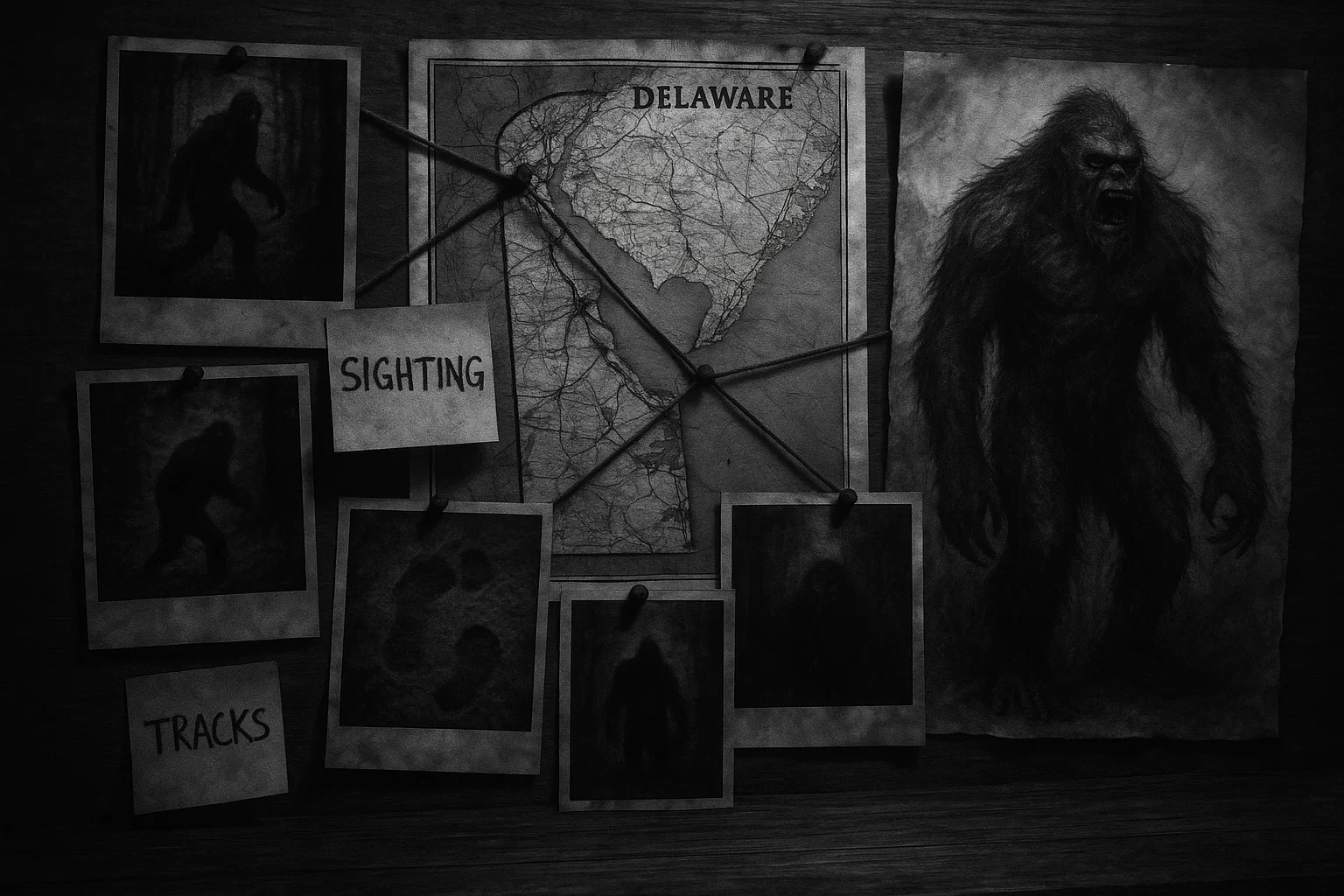Deep in the sun-scorched expanse of the Sahara Desert, where shifting sands hide ancient secrets and mirages dance on the horizon, whispers of a mysterious creature echo through nomadic tales.
The Adjule, also known as the Bush Dog, Kelb-el-khela (male), or Tarhsît (female), is a canine cryptid that has intrigued explorers, cryptozoologists, and locals since its first documented sighting in 1928 by French naturalist Théodore Monod.
With its crimson skin, webbed feet, and pack-hunting behavior, this phantom canine defies scientific classification, sparking debates about whether it’s an undiscovered species, a misidentified animal, or a spectral entity born from desert folklore.
Is the Adjule a relic of a forgotten ecosystem, a supernatural predator, or a trick of the Sahara’s harsh environment?
This article delves into the Adjule’s origins, appearance, habitat, sightings, evidence, theories, and comparisons with other canine cryptids, uncovering the enigma of this elusive creature in one of the world’s most unforgiving landscapes.
Table of Contents
What Is the Adjule?
The Adjule is a cryptid canine reported to roam the desolate regions of North Africa, particularly near the Sahara Desert and Morocco’s Atlas Mountains.
Known locally as Kelb-el-khela for males and Tarhsît for females, the name “Adjule” derives from the Tamahaq language spoken by the Tuareg people, a nomadic Berber group.
First documented in 1928 by Théodore Monod, a prominent French naturalist and Sahara explorer, the Adjule is described as a wolf-like creature with distinctive traits that set it apart from known canines like the African wild dog (Lycaon pictus) or golden jackal (Canis aureus).
Local accounts, primarily from Tuareg nomads, portray it as a cunning predator that hunts in packs of three to thirteen, blending seamlessly into the desert’s harsh terrain. Some legends attribute supernatural abilities to the Adjule, such as emitting pheromones to sow discord among humans, aiding its predatory tactics.
Despite its vivid descriptions, the Adjule’s existence remains unproven, with no physical specimens, photographs, or videos to substantiate claims. Cryptozoologists speculate it could be an undiscovered species, a genetic variant of a known canine, or a mythological entity rooted in the cultural tapestry of the Sahara’s indigenous peoples.
You May Also Like: Vassago: The Demon Who Pretends to Be an Angel
What Does the Adjule Look Like?
The Adjule is described as a striking and peculiar creature, standing approximately two and a half feet tall at the shoulder and weighing between thirty to forty-five pounds.
Its most distinctive feature is its crimson skin with a bluish tint, a coloration that makes it stand out against the Sahara’s muted tones. Unlike typical canines with fur, the Adjule’s skin is reported as rough and thick, possibly an adaptation to the desert’s abrasive environment.
Another anomaly is its webbed feet, a trait unusual for a desert-dwelling animal, suggesting possible adaptations for navigating sandy or muddy terrains near scarce water sources.
Witnesses describe the Adjule as wolf-like in build, with a robust frame, powerful jaws, and a sleek silhouette suited for swift movement across dunes. Its eyes are often noted for their intense glow, particularly under moonlight, enhancing its spectral reputation.
The creature is said to travel in packs, displaying coordinated hunting behaviors similar to wolves or African wild dogs, but its unique physical characteristics—especially the crimson hue and webbed feet—set it apart from any known species, fueling speculation about its origins.
Habitat
The Adjule is primarily associated with the Sahara Desert, a vast, arid expanse covering 11.7 million square miles across North Africa, including Mauritania, Mali, Algeria, and parts of Morocco.
This unforgiving landscape features sand dunes, rocky plateaus, and sparse oases, with temperatures soaring to 120°F during the day and plummeting at night. The Sahara’s minimal vegetation, dominated by acacias and date palms, and scarce water sources make it a challenging habitat for large predators, raising questions about the Adjule’s survival strategies.
Sightings are concentrated in Mauritania, particularly its western coastal regions, where nomadic Tuaregs traverse the desert with their herds. The Atlas Mountains in Morocco, with their rugged peaks, pine forests, and deep valleys, also feature in reports, suggesting the Adjule may inhabit diverse terrains.
The Atlas region, spanning 1,500 miles, offers more water and prey, such as Barbary sheep and gazelles, potentially supporting a small canine population.
The Sahara and Atlas Mountains are steeped in paranormal lore. The desert is linked to tales of djinn, supernatural beings in Islamic mythology, believed to haunt remote oases and influence human behavior, much like the Adjule’s alleged pheromone powers.
The Hoggar Mountains in Algeria, another reported Adjule habitat, are associated with the Saharan Wolf, a cryptid canine with similar wolf-like traits. Local Berber and Tuareg folklore includes stories of phantom predators that vanish into the dunes, possibly inspired by mirages or the desert’s disorienting vastness.
The Atlas Mountains host legends of the Aicha Kandicha, a female spirit said to lure men, and sightings of the Marozi, a spotted lion-like cryptid. Historically, the Sahara was wetter during the Neolithic Subpluvial (circa 7000–3000 BCE), supporting larger fauna, which may explain tales of surviving prehistoric species.
You May Also Like: Who Is Seere? The 70th Demon of the Ars Goetia
The region’s isolation, coupled with its history of ancient trade routes and lost civilizations like the Garamantes, fosters a sense of mystery, making it a hotspot for unexplained phenomena and cryptid sightings.
Adjule Sightings
The Adjule’s legend rests on a handful of reported sightings, primarily from Mauritania and Morocco, spanning nearly a century.
| Date | Location | Witness | Description |
|---|---|---|---|
| 1928 | Adrar, Mauritania | Théodore Monod | Pack of five wolf-like creatures with crimson skin and webbed feet observed near a Tuareg encampment. |
| 1965 | Timbuktu, Mali | Amar Ould Sidi (Tuareg nomad) | Seven Adjules with glowing eyes stalked a camel caravan at dusk, retreated when fires were lit. |
| 1983 | Koro Toro, Chad | Hassan Mahamat (pastoralist elder) | Ten Adjules attacked livestock, showing crimson fur and silent coordination. |
| 1992 | Nouakchott, Western Mauritania | Mohamed Diop (hunter) | Eight Adjules hunted a gazelle, displaying red skin and webbed feet. |
| 2009 | Oukaimeden, Atlas Mountains, Morocco | Ahmed Bouzid (Berber shepherd, reported to Carl Marshall) | Three Adjules seen on rocky slopes, with crimson coats and silent movement. |
| 2015 | Dakhla, Western Sahara | Elena Ruiz (tourist) | Lone Adjule with red skin and webbed feet crossed a dune at twilight, unphotographed. |
1928: Théodore Monod’s Mauritania Encounter
In 1928, Théodore Monod, a renowned French naturalist and Sahara expert, reported the first documented sighting of the Adjule during an expedition in Mauritania’s Adrar region.
While studying desert flora and fauna, Monod observed a pack of five wolf-like creatures near a Tuareg encampment. He noted their crimson skin and webbed feet, describing them as unlike any known canine.
Monod’s detailed sketches, though not publicly available, emphasized their bluish tint and agile movements. His account, published in the Bulletin de la Société Zoologique de France, sparked scientific curiosity but lacked physical evidence, as the creatures fled before he could collect samples.
1965: Tuareg Nomad Sighting in Mali
In August 1965, a Tuareg nomad named Amar Ould Sidi reported encountering a pack of seven Adjules near Timbuktu, Mali. While guiding his camel caravan through a dry wadi, Sidi claimed the creatures stalked his group at dusk, their glowing eyes visible from a distance.
He described them as two and a half feet tall, with rough, red skin and a sinister presence. The pack retreated when Sidi’s group lit fires, leaving no tracks due to the hard desert surface.
This sighting, shared orally among Tuaregs, was later documented by anthropologist Jean Gabus in 1970, adding credibility due to Sidi’s reputation as a reliable guide.
1983: Koro Toro, Chad Incident
In March 1983, a group of pastoralists in Koro Toro, Chad, reported a pack of ten Adjules attacking their livestock near an oasis. Led by elder Hassan Mahamat, the group described the creatures as wolf-like with crimson fur and webbed paws, moving swiftly across the sand. The attack lasted minutes, with two goats killed before the pack vanished.
Mahamat’s account, recorded by a local French aid worker, noted the creatures’ silent coordination, unlike typical wild dogs. No physical evidence was collected, but the incident fueled local fears of a supernatural predator.
You May Also Like: The Hope Diamond Curse: Deaths, Ruins, and Mystery
1992: Western Mauritania Hunters’ Sighting
In July 1992, hunters from a village near Nouakchott, Western Mauritania, reported the most recent confirmed sighting of a pack of eight Adjules. Led by Mohamed Diop, the group encountered the creatures while tracking gazelles.
Diop described them as two and a half feet tall, with red skin and webbed feet, hunting with eerie precision. The pack ignored the hunters, focusing on a gazelle, which they killed and dragged away.
The sighting, reported to local authorities, was investigated by a wildlife officer who found no tracks, likely due to wind-swept sand. This remains the last widely accepted sighting.
2009: Atlas Mountains Berber Reports
In October 2009, cryptozoologist Carl Marshall visited Morocco’s High Atlas Mountains and interviewed Berber shepherds who claimed to have seen small packs of Adjules infrequently.
One shepherd, Ahmed Bouzid, recounted spotting three Adjules near Oukaimeden in September 2009. He described their crimson coats and webbed feet, noting their silent movement across rocky slopes.
Bouzid’s account, though second-hand, suggested the Adjule’s range extends beyond the Sahara. Marshall’s investigation found no physical evidence, but the consistency of descriptions intrigued him.
2015: Unconfirmed Western Sahara Sighting
In February 2015, a Spanish tourist, Elena Ruiz, claimed to have seen a lone Adjule while traveling near Dakhla, Western Sahara. Ruiz, an amateur photographer, described a red-skinned canine with webbed feet crossing a dune at twilight.
Her attempt to photograph the creature failed due to low light, and no tracks were found the next day. The sighting, shared on a cryptozoology forum, remains unverified but aligns with earlier descriptions, suggesting the Adjule’s persistence in remote areas.
Evidence, Investigations, and Theories
The Adjule’s existence hinges on eyewitness accounts and oral traditions, with no tangible evidence to confirm its reality.
Evidence
No photographs, videos, footprints, or physical specimens of the Adjule exist, despite its reported sightings. Descriptions of crimson skin, webbed feet, and pack behavior come solely from witnesses, including credible figures like Théodore Monod and local Tuaregs.
The absence of tracks is often attributed to the Sahara’s wind-swept sands or rocky terrains, which erase evidence quickly. Artistic renderings based on accounts depict a wolf-like creature with an eerie glow, but these are speculative.
The lack of fossils or biological samples undermines claims, though the Sahara’s vastness makes such discoveries challenging.
Investigations
The Adjule has seen minimal scientific scrutiny due to the Sahara’s logistical challenges—extreme heat, vast distances, and sparse infrastructure deter expeditions.
Théodore Monod’s 1928 report, published in a scientific journal, prompted brief interest, but no follow-up studies were conducted. The 1992 Mauritania sighting was investigated by a local wildlife officer, who found no evidence due to environmental conditions.
Carl Marshall’s 2009 interviews in the Atlas Mountains yielded compelling anecdotes but no physical proof. Modern tools like camera traps or drones have not been deployed, likely due to the region’s inaccessibility and the Adjule’s rarity.
Cryptozoologists like George Eberhart have documented the Adjule in reference works, but no large-scale searches have been mounted.
You May Also Like: The Portrait of Doña Isabel de Porcel Curse: Real or Not?
Theories
Several theories attempt to explain the Adjule, each with strengths and limitations:
Misidentified African Wild Dog
The leading theory posits that the Adjule is a misidentified African wild dog (Lycaon pictus), possibly with mange altering its appearance. African wild dogs are pack hunters with a mottled coat, but their range is typically sub-Saharan, not the deep Sahara.
The crimson skin and webbed feet don’t match, though mange could create a reddish, hairless look. Théodore Monod’s expertise suggests he would recognize a wild dog, weakening this theory.
However, rare vagrant populations in the Sahara during wetter periods (e.g., the Neolithic Subpluvial) could explain early sightings.
Likelihood: Most likely due to known canine presence, but discrepancies in description reduce certainty.
Unknown Canine Species
Cryptozoologists propose the Adjule could be an undiscovered canine species adapted to desert life. The Sahara’s unexplored regions and past wetter climates support the possibility of isolated populations.
The webbed feet might aid in navigating sandy or oases-adjacent terrains, and crimson skin could be a camouflage or heat-resistant adaptation. However, the lack of fossils, tracks, or DNA evidence makes this speculative.
The Atlas Mountains’ biodiversity supports this theory more than the barren Sahara.
Likelihood: Possible but unlikely without physical evidence.
Supernatural Entity
Local Tuareg and Berber folklore attributes supernatural powers to the Adjule, such as pheromone manipulation to confuse prey or humans. This aligns with regional beliefs in djinn or spirit animals, but no empirical evidence supports these claims.
The glowing eyes and spectral aura may stem from mirages or desert isolation, which can distort perceptions.
Likelihood: Unlikely, as it relies on cultural mythology rather than verifiable data.
Hoax or Misremembering
The Adjule could be a product of exaggeration, misidentification, or optical illusions caused by the Sahara’s extreme heat and mirages. Witnesses may have seen golden jackals or feral dogs under poor visibility, mistaking them for a new creature.
The webbed feet and crimson skin could result from mange, sunburn, or hallucinations induced by dehydration. However, consistent descriptions across decades and Monod’s credibility challenge this theory.
Likelihood: Plausible but less convincing given multiple independent accounts.
Extinct Prehistoric Canine
Some suggest the Adjule could be a surviving prehistoric canine, like a descendant of the short-faced hyena or an ancient wolf species, from the Sahara’s wetter past.
The Neolithic Subpluvial supported diverse fauna, and isolated populations could have persisted. However, no fossils or genetic evidence support this, and the webbed feet don’t align with known prehistoric canines.
Likelihood: Unlikely due to lack of paleontological support.
You May Also Like: The Minneapolis Mystery | Horror Story
Comparison With Other Similar Cryptids
The Adjule shares traits with other canine cryptids worldwide, particularly those in harsh or remote environments:
| Cryptid | Location | Description | Behavior |
|---|---|---|---|
| Black Shuck | East Anglia, England | Large black dog, glowing red eyes | Omen of death |
| Barghest | Northern England | Black dog with fiery eyes, large teeth | Harbinger of doom |
| Hellhound | Global (Western folklore) | Black dog, red eyes, fiery breath | Guards underworld |
| Beast of Gevaudan | France | Wolf-like, thick coat, long tail | Attacked humans |
| Dogman | USA (Michigan, Wisconsin) | Bipedal canine, fur-covered | Elusive, sometimes aggressive |
| Waheela | Canada (Nahanni Valley) | Large white wolf-like creature | Solitary predator |
| Shunka Warakin | USA (South Dakota, Montana) | Wolf-hyena hybrid | Attacks livestock |
| Cadejo | Central America | White or black dog, glowing eyes | Protects or harms travelers |
| Dingonek | Congo, Western Africa | Canine-like, horns, scaly | Attacks large animals |
| Inugami | Japan | Dog spirit, spectral form | Serves as familiar |
| Salawa | Egypt | Canid, blamed for killings | Aggressive |
The Adjule’s crimson skin and webbed feet are unique, distinguishing it from spectral canines like the Black Shuck or Hellhound, which emphasize supernatural traits.
Its pack behavior aligns with the Beast of Gevaudan and Shunka Warakin, but its desert habitat contrasts with their forested or temperate ranges.
The Salawa and Dingonek, also African, share the Adjule’s canine form and predatory nature, but lack its specific physical anomalies, making the Adjule a singular mystery.
Is the Adjule Real?
The Adjule remains one of cryptozoology’s most tantalizing puzzles, its existence unconfirmed by empirical evidence yet persistent in folklore and eyewitness accounts.
The Sahara’s vast, unexplored terrain and the Atlas Mountains’ rugged isolation make the idea of an undiscovered canine plausible, especially given past discoveries of species like the okapi or coelacanth, once considered cryptids.
However, the absence of photographs, tracks, or DNA strongly supports the misidentification theory, likely involving African wild dogs or golden jackals altered by mange or desert conditions. The crimson skin and webbed feet remain unexplained, though environmental factors or optical illusions could play a role.
Théodore Monod’s 1928 account lends credibility, but the lack of recent sightings since 1992 (with 2009 and 2015 reports being less substantiated) suggests the Adjule may be a fading legend. Supernatural explanations, while culturally rich, lack scientific grounding, and the hoax or misremembering theory struggles against consistent descriptions across decades.
The most likely explanation is a misidentified African wild dog, possibly from a now-extinct Sahara population, seen under conditions that exaggerated its appearance.
Yet, the Sahara’s history as a once-lush region and the possibility of undiscovered species keep the Adjule’s mystery alive.
Until camera traps, drones, or field expeditions yield concrete evidence, the Adjule endures as a haunting symbol of the unknown, lurking in the shadows of one of Earth’s harshest landscapes, waiting for its secrets to be unveiled.

